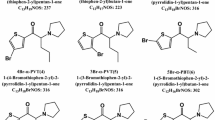Abstract
IT is an interesting fact that most of the known psychotropic phenylisopropylamines (amphetamines) possess ring-substitution patterns identical to those of natural essential oils. (The single exception is the active 2-methoxy - 4,5 - methylenedioxyamphetamine (MMDA-2, IId1); neither the allyl nor the propenyl counterpart has been observed in plant extracts.) Thus 3,4-methylenedioxyamphetamine (MDA, IIa) is related to safrole (Ia)2 (Table 1), 3,4,5-trimethoxyamphetamine (TMA) to elemicin3, 3 - methoxy - 4,5 - methylenedioxyamphetamine (MMDA, IIc) to myristicin (Ic)4 (Table 1), 2,4,5-trimethoxy -amphetamine to asarone, and 2-methoxy-3,4-methylenedioxyamphetamine (MMDA-3a, IIb) to croweacin (Ib) (Table 1). C. F. Barfknecht, of Idaho University, tells us that there is preliminary evidence that these olefines may be aminated in the living organism, and this reaction can be readily performed in vitro. There are two additional essential oils known that contain the methylenedioxy ring. These are apiole (Ie) and dillapiole (If) (Table 1). These two naturally occurring aromatic ethers are the two possible ring-methoxylated analogues of myristicin.
Similar content being viewed by others
References
Shulgin, A. T., Experientia, 20, 366 (1964).
Alles, G. A., in Symposium on Neuropharmacology (edit. by Abramson H. A.), (Madison Printing Co., Madison, N. J., 1959). Shulgin. A. T., Sargent, T., and Naranjo, C., in Ethnopharmacologic Search for Psychoactive Drugs (edit. by Efron, D., US Government Printing Office, 1967).
Peretz, D. I., Smythies, J. R., and Gibson, W. G., J. Mental Sci., 101, 317 (1955). Shulgin, A. T., Bunnell, S., and Sargent, T., Nature, 189, 1011 (1961).
Shulgin, A. T., Nature, 201, 1120 (1964).
Shulgin, A. T., J. Chromatography (in the press).
Heacock, R. A., Chem. Rev., 59, 181 (1959).
Benington, F., Morin, R. D., and Clark, L. C., J. Org. Chem., 20, 1292 (1955).
Author information
Authors and Affiliations
Rights and permissions
About this article
Cite this article
SHULGIN, A., SARGENT, T. Psychotropic Phenylisopropylamines derived from Apiole and Dillapiole. Nature 215, 1494–1495 (1967). https://doi.org/10.1038/2151494b0
Received:
Issue Date:
DOI: https://doi.org/10.1038/2151494b0
- Springer Nature Limited
This article is cited by
-
Study of the antitumor mechanisms of apiole derivatives (AP-02) from Petroselinum crispum through induction of G0/G1 phase cell cycle arrest in human COLO 205 cancer cells
BMC Complementary and Alternative Medicine (2019)
-
Determination of myristicin in rat serum samples using microbore high performance liquid chromatography with column-switching
Chromatographia (1998)





